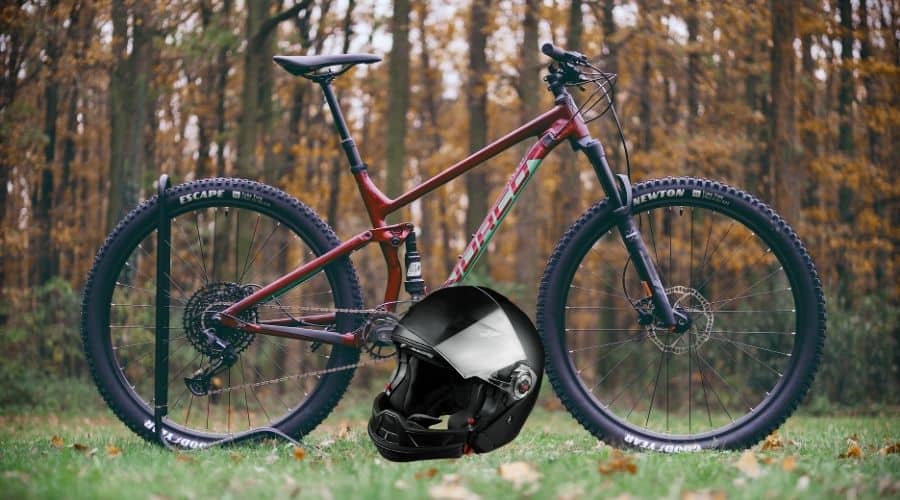Motorcycle and bicycle helmets need to fit right to do their job protecting your head. A snug-fitting helmet can mean the difference between brain damage and walking away from a crash relatively unharmed, but that doesn’t mean all helmets are the same. Can you wear a motorcycle helmet on a bicycle?
You can wear a motorcycle helmet on a bicycle however they are heavier, less aerodynamic and less ventilated than cycling helmets. Only cyclists under the age of 16 must wear a helmet. The helmet must fit properly and be fastened securely with a strap to the head to prevent serious injury.
Recommended Gear
To see all of my up-to-date recommendations for bikes and cycling gear, check out this resource that I made for you!
Table of Contents
Motorcycle Helmet For Bicycle
Wearing a motorcycle helmet on a bicycle isn’t comfortable, but it is possible. Plus, it provides more protection than a standard bike helmet.
That means bulkier helmets typically fulfill the same requirements when it’s mandatory because they exceed the minimum. Still, you should always check your local legislation to be sure.
A motorcycle helmet isn’t the best option if you’re looking for a practical alternative to your bike helmet.
However, if you are out of choices and have a motorcycle helmet available, use it by all means.
Is A Bike Helmet The Same As A Motorcycle Helmet
Bike helmets and motorcycle helmets both protect your head in the case of a collision, but that’s about all they have in common.
A bike helmet is not the same as a motorcycle helmet because it’s made for a frontal impact at a much lower speed.
The two styles have different certifications, and while they are purpose-built for similar jobs, the way they accomplish them and some of the critical details are very different.
Bike Helmet vs Motorcycle Helmet
The fundamental differences between motorcycle and bicycle helmets are about much more than looks. You may be surprised by some differences, especially if you haven’t worn both types in the past.
Below I’ve listed the most significant factors separating a bike helmet and motorcycle helmet:
- Laws – Every state in the US has a law requiring some motorcyclists, typically those 25 or younger, to wear a helmet, but only a few states require bicycle helmets.
- Interchangeability – You can technically wear a motorcycle helmet on a bike. A more robust helmet will save your skull, but the reverse isn’t true. If you wear a bike helmet on a motorcycle, it won’t protect you.
- Weight – Motorcycle helmets are substantially stronger and more durable than bicycle helmets. You are more likely to be in a high-speed accident on a motorcycle because of their engines, so motorcycle helmets have more bulk from the tougher outer shell and denser foam.
- Coverage – Bicycle helmets usually cover the top and front of your head because cyclists are typically in head-on collisions. However, a motorcycle helmet often gives full coverage and offers a face shield to prevent insects and debris from getting in your eyes at twenty to seventy miles per hour. Although not all motorcycle helmets provide full coverage, bicycle helmets never have that option.
- Ventilation – Road bike helmets have a lot of vents that are open holes, while some bike helmets have fewer and smaller vent holes in them. According to Billy’s Crash Helmets, “Helmets usually have a vent or two on the chin bar too. These route air onto the back of the shield to help stop the shield misting up – and sometimes route air to the chin for extra ventilation around the jaw.”
- Aerodynamics – Cycling helmets, especially those for road bikes, tend to be designed for aerodynamics because a rider’s speed depends on minimizing friction as they ride. A motorcycle helmet doesn’t need to be aerodynamic because the momentum on a motorized vehicle comes primarily from the engine.
Bike Helmet Certifications
Bicycle helmets in the US are Consumer Product Safety Commission approved. They need a certification that says ASTM F1492.
Meanwhile, motorcycle helmets get their safety certification from the Department of Transportation.
The CPSC has rigorous test standards and specific labeling requirements. You can read all about them here.
Can You Use A Motorcycle Helmet For Mountain Biking
You could use a motorcycle helmet for mountain biking, but you can also use bricks to make the soles of your shoes.
A typical bike helmet weighs around twelve ounces, or about three-quarters of a pound. Alternately, a motorcycle helmet normally weighs over three pounds.
If you are trying to get up a mountain, the added weight will hold you back. Then when you head back down the mountain, the extra weight on the downslopes can be a danger to your balance.
Can You Use A Motorcycle Helmet For Cycling
You can use a motorcycle helmet for cycling, but you’ll look ridiculous. More importantly, it will slow you down, which often defeats the purpose of cycling.
Plus, you cannot wear a motorcycle helmet if you cycle competitively. The rules for what you can wear are more likely to specify the types of helmet you can wear in competition, and a big bulky motorcycle helmet won’t make the cut.
Why Don’t Cyclists Wear Motorcyclist Helmets
Cyclists don’t wear motorcycle helmets because they are less aerodynamic and heavier than bicycle helmets.
Unlike a motorized vehicle, the bike rider has to put all the energy into moving.
They are quite literally the engine that powers their vehicle, so every added pound and wind-catching, friction-creating addition means the rider works harder for less reward.
A little added drag and weight may not seem like a big deal, but it adds up over time. Motorcycle helmets fatigue bike riders.
Worse still, they are hot and hard to hear out of, making this style both uncomfortable and dangerous for a bicycle rider.
In short, it’s not worth the tradeoff for a better head protector.
Helpful Tips To Know About Wearing A Motorcycle Helmet On A Bicycle
If you ride a bike, it’s vital to protect your head, but a motorcycle helmet may take things a bit too far. You probably don’t need a helmet designed for high-speed impacts, even if you can technically have one.
Here are more helpful tips to know about wearing a motorcycle helmet on a bicycle.
- In addition to a motorcycle helmet and a bike helmet, there’s a third style that is roughly halfway between called a motocross helmet. This style is a full-coverage helmet with a face shield, but it’s more aerodynamic and may have a visor like a bike.
- Unlike a bicycle helmet, motorcycles have a Department of Transportation or DOT certification. This means they are approved for use on motorized vehicles. There should be a sticker with “DOT” on all new helmets to indicate they passed the minimum requirements to help keep you safe.
- Some areas have more specific bicycle laws than others. That means your city may require a particular type of bicycle helmet. In those rare cases, you would not legally be allowed to wear a motorcycle helmet while riding your bike on public property, but you could still do so on private land.
Final Thoughts
There’s no rule against wearing a motorcycle helmet, and it’s not likely that bike helmet laws would prevent you from protecting your head more than necessary.
However, most cyclists don’t wear motorcycle helmets because they aren’t needed for lower-speed impacts.
Moreover, a motorcycle helmet is heavy, hard to hear in, and they get uncomfortably hot inside, especially the style with a full-face shield.
Plus, a bike helmet is more aerodynamic. Wearing a motorcycle helmet on a bicycle would slow you down. That said, you can do it if you choose.

